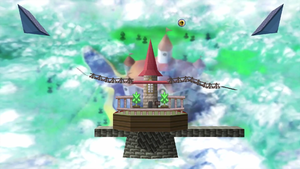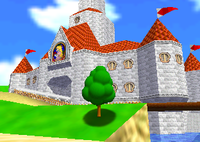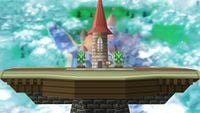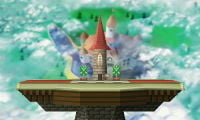| Welcome to SmashWiki! Log in or create an account and join the community, and don't forget to read this first! |
| Notices |
|---|
| The Skill parameter has been removed from Smasher infoboxes, and in its place are the new "Best historical ranking" and "Best tournament result" parameters. SmashWiki needs help adding these new parameters to Smasher infoboxes, refer to the guidelines here for what should be included in these new parameters. |
| When adding results to Smasher pages, include each tournament's entrant number in addition to the player's placement, and use the {{Trn}} template with the matching game specified. Please also fix old results on Smasher pages that do not abide to this standard. Refer to our Smasher article guidelines to see how results tables should be formatted. |
| Check out our project page for ongoing projects that SmashWiki needs help with. |
Peach's Castle
| Peach's Castle | |
|---|---|
 Peach's Castle in Super Smash Bros. for Wii U. File:MarioSymbol(preBrawl).png | |
| Universe | Mario |
| Appears in | SSB SSB4 |
| Availability | Starter (SSB) Downloadable (SSB4) |
| Crate type | Normal |
| Maximum players | 8 |
| Tracks available | In SSB: Track #5 In SSB4: 3DS version: Peach's Castle Stage Main Theme (Super Mario 64) (Alternate) Wii U version: Peach's Castle Stage Main Theme (Super Mario 64) Slide Ground Theme (Super Mario Bros. 3) Ground Theme (Super Mario Bros. 2) |
| Article on Super Mario Wiki | Princess Peach's Castle |
| “ | A bumper floats above the center of this stage. Watch where you jump, or you'll get bumped sky-high! | ” |
| —Super Smash Bros's instruction manual | ||
Peach's Castle (ピーチ城上空, Above Peach Castle) from Super Mario 64 is Mario & Luigi's home stage in Super Smash Bros. In 1P Game, the player fights a Mario and Luigi team on this stage.
Even though this stage does not appear in Super Smash Bros. Melee, a portion of the music that plays on it plays during the cutscene where Luigi takes Mario's place in Melee's Adventure Mode.
Peach's Castle returned as downloadable content in both versions Super Smash Bros. 4 on July 31st, 2015, alongside Hyrule Castle. Like other returning stages from the first Smash game, some of the textures are slightly higher in quality, but the general overall primitive look of the original is retained.
Layout
Peach's Castle has two main platforms, one on top of another. It is possible to fall through the top platform. The bottom platform partially comprises a block going left to right. On the top two corners there are two floating, inward-angled platforms that prevent people from being smashed away too easily. These platforms are very easy to DI off of as well. It has a floating Bumper on the middle above the second platform of the stage. This bumper moves slightly left and right (it remains stationary on 1P Mode though). It is difficult for most characters to recover on this stage since the two floating platforms limit recovery to the top platform and there are no ledges that can be grabbed, with the moving black platform on the bottom of the stage greatly aiding recovery, but it isn't always on the side the player is on). In Super Smash Bros. for Wii U however, fighters can now grab onto the bottom platform.
Ω Form
In competitive play
According to the American ruleset, Peach's Castle is usually considered a counterpick. This is because of the inability to grab the edges, meaning that some characters can be gimped or edgeguarded much easier than usual, and the Bumper hazard and angled platforms on the side of the stage that can prevent KO moves that would have otherwise KO'd. However, the Bumper can be used for various unique combos, and can also be used by characters such as Pikachu to escape pressure. The stage is often counterpicked by Jigglypuff and Kirby players, and the lack of edges that can be grabbed serves as a disadvantage to characters such as Link and Captain Falcon. In the Japanese ruleset, the stage is banned as with every other stage except for Dream Land, due to the reasons mentioned above. It is also occasionally banned in doubles tournaments, due to the listed reasons along with the fact that the stage is too small.
Origin

This stage's elements come from Super Mario 64. The stage takes place in the sky above Peach's Castle; in the background, it can be seen that Peach's Castle is very far below the actual stage. The sign seen on the lower level is also from the game, and the bridges likely are inspired by the broken bridges seen in the Cool, Cool Mountain course. The triangular-pyramidal platforms seen on the upper sides of the stage resemble the ones seen in stages with dangerous ground, like Lethal Lava Land, which moves around in accordance to Mario's placing. Unlike said platforms, these ones do not move at all, let alone are not activated by weight. The structure and platform of the stage, also ressemble to Whomp's Fortress course.
The music is a remixed version of the original Super Mario Bros. theme. It can also be heard in Melee during the cutscene in Adventure Mode before the fight with Luigi, though the track is absent in the Sound Test.
Gallery
Peach's Castle in Super Smash Bros. for Nintendo 3DS.
Trivia
- In early screenshots of the stage select screen of the original Super Smash Bros., this stage went by the name "In the Sky of Castle Peach".
- One of Peach's Castle's hazards is a bumper, which is mostly used as an item. Coincidentally, this is the first stage to use an item as a hazard, and have a hazard outside of its own universe; Peach's Castle is from Mario and the Bumper is from Super Smash Bros.
- Even though the bumper was updated in Super Smash Bros. 4, the original design and animation is retained in this stage.
External links
| show Stages in Super Smash Bros. |
|---|
| show Stages in Super Smash Bros. 4 |
|---|
| show
|
|---|






